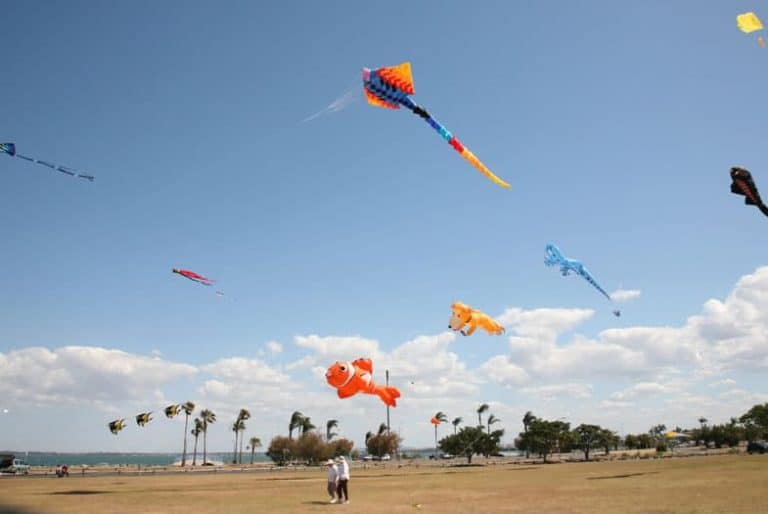Can A Kite Go Into Space? (We Find Out)
Have you ever wondered if kites can go into space? Kites are used as a recreation or sporting activity in different countries, and since they consist of a light frame and soft material, it’s easy to assume you can fly them in any condition.
No, you cannot fly a kite in space. Wind lift is required to fly a kite, and wind generation requires a dense gas atmosphere. There is no significant density of gases in space to generate wind or lift. The same is true of the Moon.
In this article, I’ll explain why kite flying in space is impossible.
Flying A Kite on Earth
The following are properties of a kite that determine how they react to lift and force.
- The total surface area of the kite
- Weight of materials used for the kite
- Weight and type of kite line used
- Shape of the kite
To launch and fly a kite, start by holding your kite up at the control point. The wind should be at your back. You should feel the lifting force if there is enough wind.
Now let some of the line out. As long as the wind is strong enough to counter the kite’s weight, it will lift.
Allow the kite to fly from you for a little distance, then pull in on its line as it points up so it will climb. You should repeat this procedure until the kite gains the elevation necessary to find good steady wind.
So can you fly a kite in space?
A kite needs an lift force to take off. Lift is absent if there is no air moving past its surfaces. There are gases in space, but molecules are so spread out that it’s like having nothing there. It means that the force required for a kite to fly is unavailable.
So the procedure in the previous section cannot be applied in space. There is no wind to launch and maintain lift needed to fly the kite.
Launching anything into space requires a massive amount of energy. If wind cannot generate the needed energy to overcome gravitational downward force, it will not fly.
There is not enough wind in space (excluding solar wind which is a different kind of force) even to lift a small object such as a kite. Experimental kites with space age materials, light weight and large surfaces can get to substantial altitudes though.
Solar wind, which is the movement of particles generated by the sun, can be harnessed to power solar sail. So far, however, this is largely hypothetical. The surface area required to capture enough energy to start movement of the sail is gigantic.
You Can’t Fly a Kite on the Moon
The Moon, Earth’s satellite, does not have the same atmosphere as the Earth. There is no air on the Moon to breathe and no moving winds. Its surface is directly exposed to outer space. The Moon does have a very thin layer of gases around the lunar surface, which we can call the ‘atmosphere,’ although technically it’s an exosphere.
For an atmosphere to exist, a strong gravitational force is needed to prevent gases from escaping whatever space object you consider. The Moon is smaller and less dense than the Earth, which means its gravity is weak compared to Earth. With such weak gravity, gases emanating from the surface easily escape into outer space.
As mentioned before, flying kites on the Moon is impossible because there is no wind. On the other hand, the Earth’s atmosphere has dense gas which reacts to heating and cooling, creating movement if those gases.
Thus wind is created, which can be harnessed for everything from powering cities, to riding in sailboats and flying kites.
All aircraft movement depends on the lift on their surfaces generated by the air around them. The generation of lift can be created by expending fuel or by the flowing of wind. The Moon has no atmosphere, and its thin layer of gases is not enough to give the kite any lift, even though gravity is weak.
The movement of molecules in the lunar atmosphere is completely different than in the Earth’s. While molecules are constantly colliding in the Earth’s atmosphere, in the lunar environment, molecules are so far apart that they barely touch each other.
They move freely in their paths determined by the energy they receive by the gravitational pull of the Moon versus solar particle interactions driving them away from the surface.
If enough energy is applied to a kite from other sources, it would be possible to overcome the moon’s gravity and fly into space. But that isn’t really flying a kite so much as launching a kite. And if you lifted a kite above the moon’s surface without enough energy to overcome gravity, it would gradually return to the surface.
Can You Fly A Kite On Mars?
The atmosphere on Mars is approximately one percent as dense as the Earth’s atmosphere. That means for a kite to fly on Mars, the rate at which wind blows would have to be faster than on Earth for the kite to get in the sky.
There is enough wind on Mars and other planets with atmospheres to lift and fly a kite at times. But lightweight kites with large surface areas could be flown in a sustained manner on Mars.
Winds on Mars can reach as high as 60 mph during Martian dust storms. These occur every 3 Martian years or so (5.5 Earth years.)
How High Can A Kite Go?
In the United States, the FAA (Federal Aviation Administration) applied some regulations on how high and where you may use a kite. According to the FAA, no one may use or fly a kite more than 150 feet above the surface of the Earth. Anyone found breaking these rules could face legal actions.
Usually, kites fly at an altitude of 200-300 feet above ground level. However, some can be seen higher up in the sky (up to 600 feet). The maximum thread length which holds the kite up is approximately 1500m.
The highest altitude by a single kite is 4,879.54 m (16,009 ft). Robert Moore achieved it in Cobar, New South Wales, Australia, on 23 September 2014. The record challenge was achieved at Cable Downs with a 50,000-acre sheep station in far western New South Wales, Australia. (source)
From our recorded latitude, it usually varies around 18,000 feet. Those are the altitudes where the jet upper-level or stream winds occupy. During the winter months, those winds can reach more than 150 mph. The Kite Moore used to break the world record was also a delta wing.
Pilots and other kite fliers are always advised to fly kites in an open field with few obstacles in their environment. Also, another essential fact to keep in mind is that the weather should not be too windy to have the perfect kite motion.
Summary
As seen above, getting a kite to fly in space is impossible. The absence of both wind prevents creation of lift. But planets and any space object with enough gravity to maintain an atmosphere and a source of energy like a sun would allow you to fly a kite, assuming the energy from the available wind exceeds the gravitational pull on the kite.






